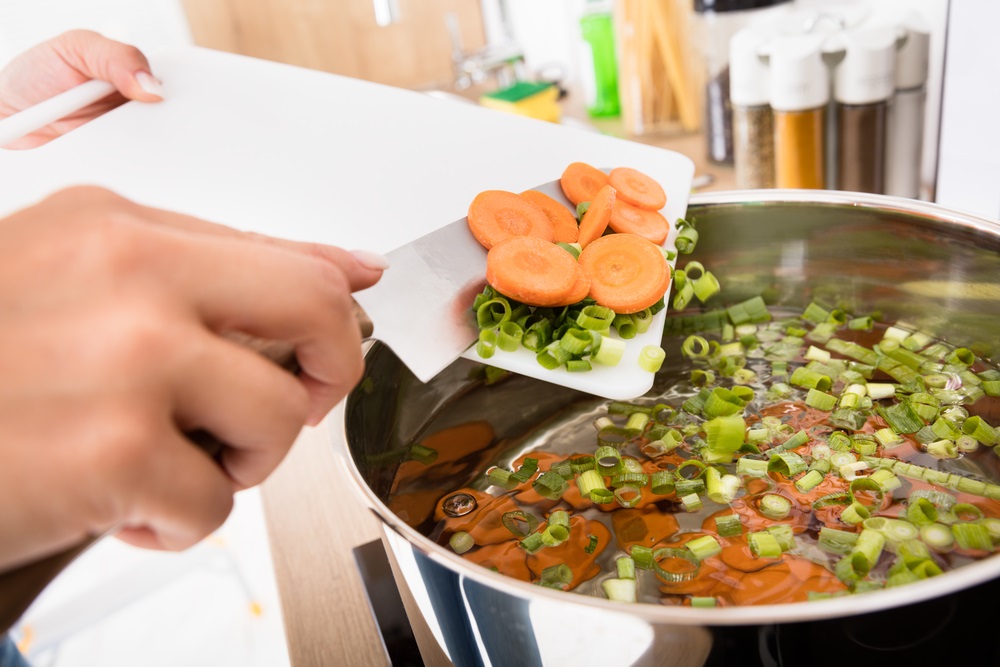What's a serve of vegetables?

For optimal health, nutritionists recommend that adults should eat five serves a day of vegetables or salad, either raw or cooked, and more if you can. But few of us eat this amount.
The amount of vegies children should eat depends on their age, appetite and physical activity levels. After about nine years old, children should eat the same serves of vegetables as adults – meaning that kids can also aim for five a day.
What’s a serve?
A serve of vegetables or legumes (such as peas, lentils and beans) is officially defined as weighing approximately 75 g (and providing about 100–350 kJ). This means:
- ½ cup cooked green or orange vegetables (such as broccoli, spinach, carrots or pumpkin)
- ½ cup cooked or canned beans, peas or lentils (preferably with no added salt)
- 1 cup leafy greens or raw salad leaves (weighing only 35–40 g)
- ½ cup cooked sweet corn
- ½ medium potato or other starchy vegetables (kumara or gold sweet potato, taro or cassava)
- 1 medium tomato
Source: Eat for Health Australian Dietary Guidelines

What is 5 + 2?
The 5 + 2 rule stands for 5 serves of veg plus 2 serves of fruit. It’s designed as a handy rule of thumb to ensure you eat right. A serve of vegetables is defined as ½ cup of most cooked vegetables, which means about ½ cup cooked carrot, broccoli, green beans or other veg. For two people for variety, I count these four vegetables as :
- 2 florets of broccoli +
- 6 long green beans +
- 8 rounds of carrot +
- 8 rounds of zucchini.
See picture of vegetables for TWO cut up and ready for the saucepan.

If we’re talking leafy salad greens, then 1 cup weighs about 35–40 g. Salad leaves have a lot of volume but don’t weigh much, which is one factor in their popularity in weight-loss diets – it looks as if you’re getting a lot but it doesn’t amount to much. Nor do salad leaves give you much in the way of kilojoules (Calories), which is good to know. Tomatoes are included here as a vegetable not a fruit.
Potatoes – do they count?
Yes, potatoes are vegetables but they are over-consumed. To my way of thinking, they should count only as one serve a day. They have lower nutritional value than other vegetables and also tend to be cooked in a lot of fat (such as hot chips or butter in mash).
Serves or cups?
Another way to think of 5 serves is in cups – this translates to 2½ cups of vegetables a day. Some vegetables, such as shredded cabbage or salad leaves, are easier to visualise in cups and this is a simpler method than weighing. To help you get used to the size of the food on your plate, you can measure or weigh your vegetables for a day or two.
A serve of fruit is defined as one medium piece, such as an apple, banana, orange or pear, or two small pieces of fresh fruit, 1 cup of diced fruit, ¼ cup of sultanas, or four dried apricot halves; this is approximately 150 g fresh fruit or 30 g dried fruit. Fruit juices are generally not considered to be fruit but you’re allowed to count ½ glass or 125 mL of no-added-sugar juice a day as one serve. A serve of fruit provides approximately 350 kJ.
Source: Eat for Health Australian Dietary Guidelines
Things that count as vegetables but don’t look like them
All these foods can include substantial amounts of vegetables, which count towards your five a day:
- Pizza toppings such as tomatoes, mushrooms and capsicums
- Spaghetti sauce (e.g. bolognaise) with hidden vegetables
- Guacamole (avocado dip)
- Soups (if you like, you can buy my ebook on soups)
- Savoury mince with grated carrot or pumpkin, or chopped beans or fennel
- Casseroles with added carrots, potatoes, celery and tomatoes
- Hot grilled corn on the cob.
Bottom line
Now you know what a serve of vegetables is and looks like. The size of a serve differs for each group of foods from bread to fruit to meat.
Related links / External websites
This post was first published in my book: The Super Powers of Veg. You can access it here.




